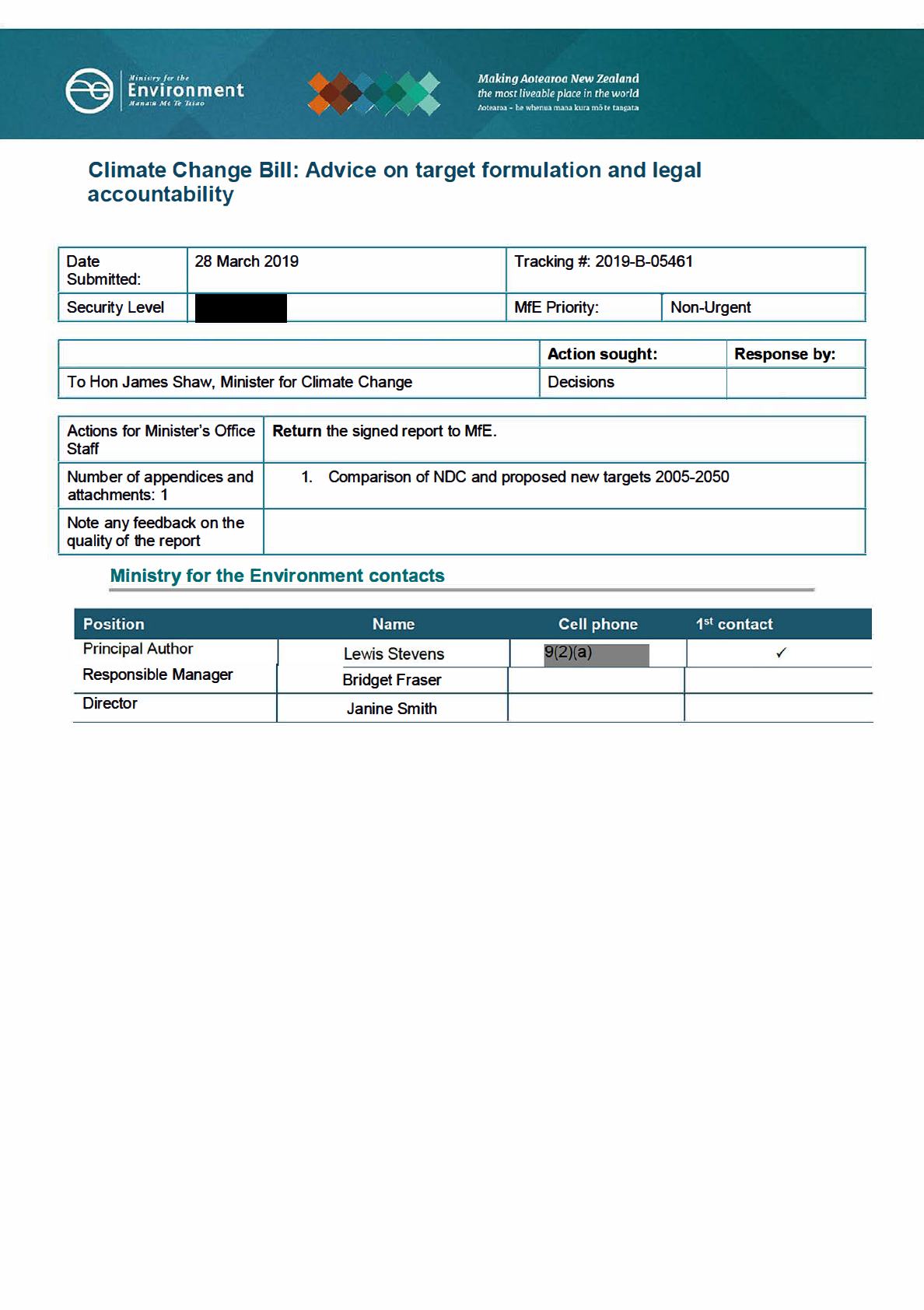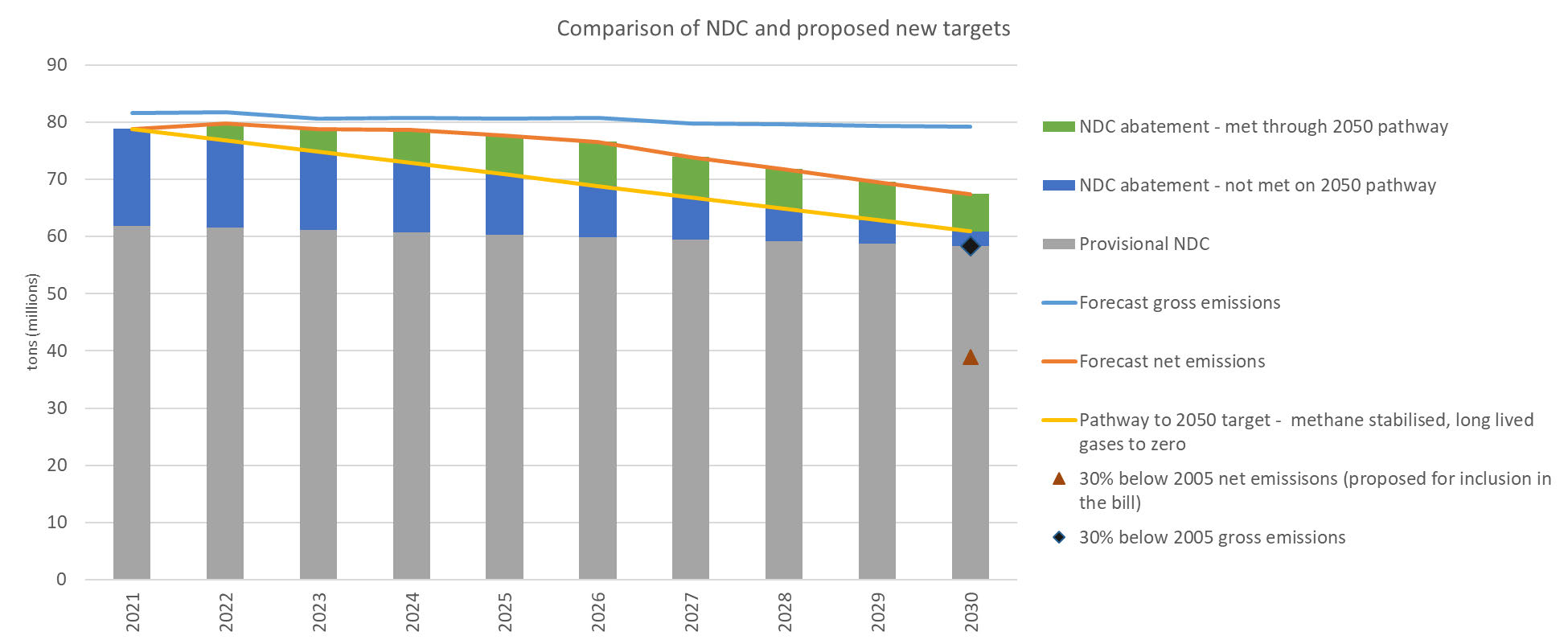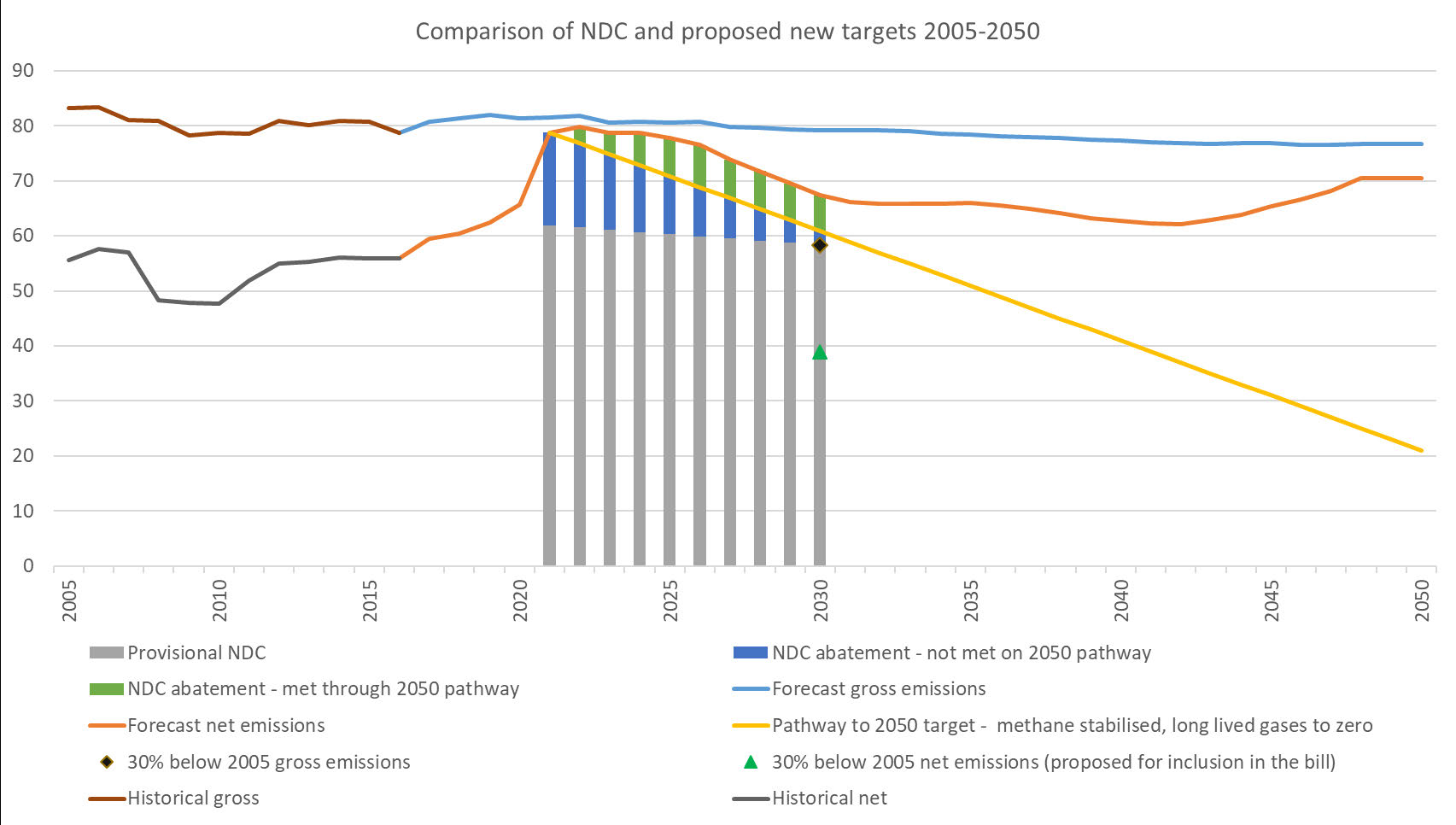
Climate Change Response (Zero Carbon) Amendment Bill: Advice on
target formulation and legal accountability
1.
As requested by your office, this briefing provides you with:
a. Advice on the implications of including a target to reduce net emissions of
greenhouse gases by 30% below 2005 levels by 2030 in the proposed new climate
change legislation.
b. Options for how to proceed in respect of legal accountability under the proposed
new legislation. This advice follows conversations with your office and the
Parliamentary Counsel Office on the drafting of the bill.
2.
These points are dealt with in turn below.
Target formulation
3.
We understand you are considering legislating a target for 2030 through the Climate Change
Response (Zero Carbon) Amendment Bill (“Bill”) to reduce net emissions of greenhouse
gases to 30% below 2005 levels by 2030; including a 10% reduction in biogenic methane
emissions below 2005 levels by 2030.
4.
This approach presents four key issues:
a. Consistency of the proposed target with our first Nationally Determined Contribution
(NDC) under the Paris Agreement, and the impact of multiple targets on the
certainty of direction for our low emissions transition
b. Distribution of effort across the economy
c. Timing of effort to reach the proposed 2050 target
d. Compatibility with the central range of IPCC scenarios consistent with limiting global
warming to 1.5°C with limited or no overshoot.
5.
These points are dealt with in turn below. The plot below shows the difference between the
various components of the target that are under discussion, and how this compares to our
first NDC. The appendix presents this same plot over the period 2005 to 2050 for context.
2

3
The impact of multiple targets on the certainty of direction for our low emissions transition
6.
The overall net emissions component of the proposed target appears similar to our first NDC
under the Paris Agreement, but differs in three important ways which would cause it to drive
materially different outcomes. The following table sets out these differences.
Target formulation
Gross or net
Emissions budget or Treatment of
baseline?
point in time?
forestry
NDC
Gross
Budget
Averaging
A 30% reduction in net Net
Point in time
Not specified1
greenhouse gas
emissions below 2005
levels by 2030
7.
Achieving the proposed point-year target domestically would mean our emissions in 2030
would be significantly below the trajectory indicated by the proposed formulation for the 2050
target. Please refer to the plot above for illustration.
8.
An efficient transition depends on a clear and stable long-term signal of the emissions
reductions required across the economy. Adopting and legislating multiple targets reduces
this clarity and stability, and would compromise the efficiency of the transition.
9.
It is important to note that regardless of what target is legislated through the Bill, New Zealand
remains committed to its NDC.
Distribution of effort across the economy
10. The proposed target form will impact how the burden of meeting it is spread across the
economy. If the 10% reduction in gross emissions of biogenic methane emissions is met, this
would require us to offset or reduce 44% of our gross emissions levels of other greenhouse
gases in order to meet the proposed overall 30% reduction target.
11. If such a target formulation is progressed, we recommend explicit consideration is made of
how impacts are likely to be distributed across the economy.
Timing of effort to meet the 2050 target
12. Achieving a 30% reduction in emissions on a 2005 baseline by 2030 by domestic emissions
reductions and removals alone will put us on a much steeper emissions reduction trajectory
than that implied by the proposed target for 2050.
13. The plot in the appendix to this paper illustrates this point.
14. Making deeper reductions earlier could increase the overall costs to the economy, and pre-
empt technology development that could support a gradual and efficient transition. While this
could result in better climate outcomes though us reducing emissions earlier, it constrains
the choices we have in how we achieve a transition that is just and efficient.
15. If such a target formulation is progressed, we recommend explicit consideration is made of
the timing and impact of emissions reductions across the economy.
Compatibility with the central range of IPCC scenarios consistent with limiting global warming
to 1.5°C with limited or no overshoot.
16. The proposed formulation of the 2050 target for biogenic methane calls strongly on the
1 We have assumed UNFCCC reporting approach in our calculations as this is the data we have for 2005
4
IPCC’s central range of scenarios consistent with limiting global warming to 1.5°C with limited
or no overshoot.
17. The IPCC reports global emissions reductions in 2030 under the same scenarios. These
indicate a central range of reductions in agricultural methane emissions between 11% and
30% on 2010 levels.
18. Converting these figures to a baseline of New Zealand’s 2005 biogenic methane emissions
(in line with the proposed target for 2030) gives an emissions reduction range of 16% and
34%.
19. The IPCC does not prescribe any policy approach or target, and the global emissions
reductions do not necessarily apply to an individual country, but given the weight placed on
its scenarios in the 2050 target formulation we recommend that this be considered in any
decision on a 2030 target.
Legal accountability
20. s9(2)(g)(i)
21. s9(2)(g)(i)
Out of scope
22.
23. 9(2)(g)(i)
24.
5
Recommendations
25. We recommend that you:
a.
Discuss the advice on the target formulation with officials
Yes/No
Out of scope
b.
c.
Signature
Janine Smith
Director
Climate Change
Hon James Shaw
Minister for Climate Change
Date
6
 Appendix: Comparison of NDC and proposed new targets 2005-2050
Appendix: Comparison of NDC and proposed new targets 2005-2050
7


